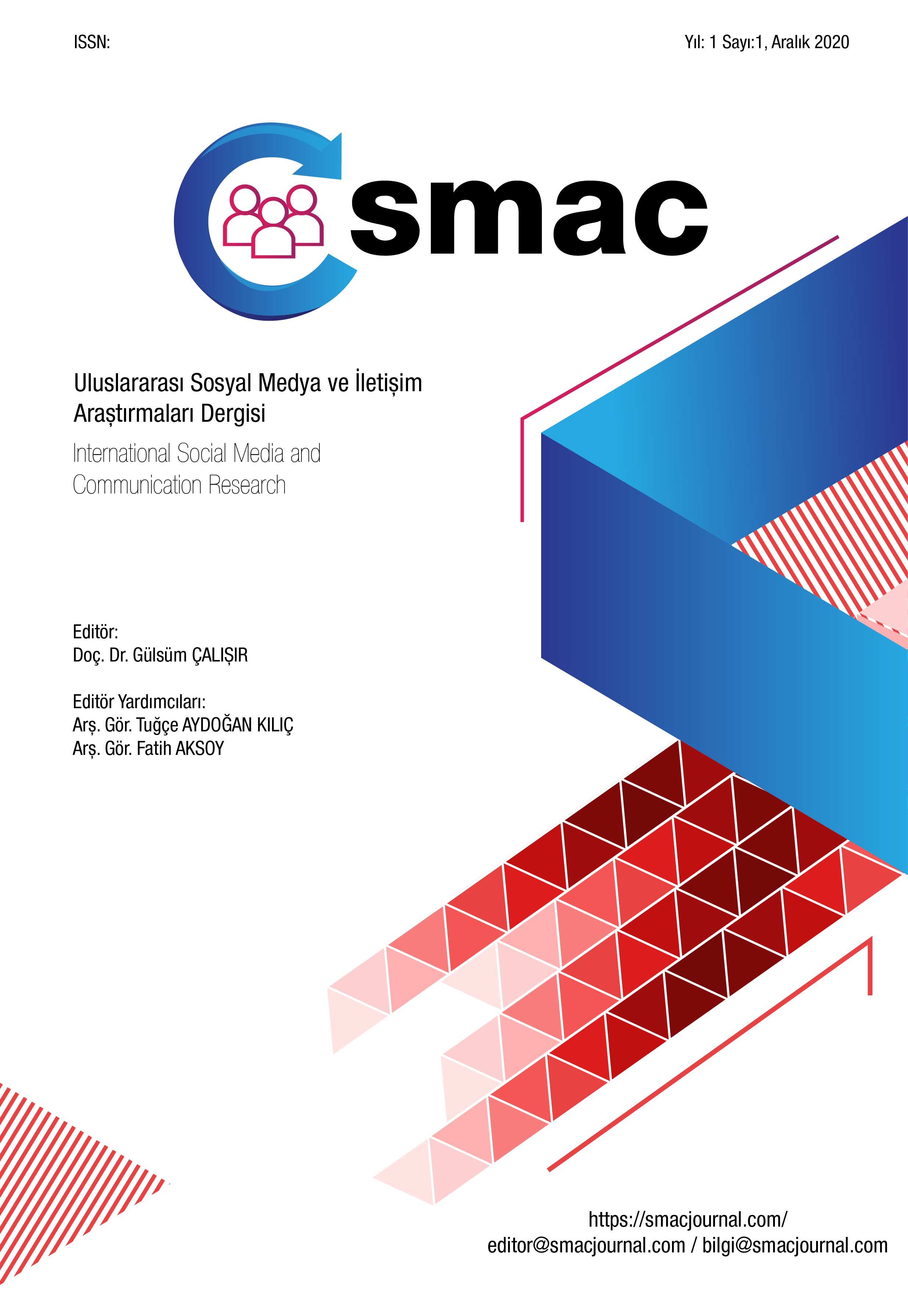Author :
Abstract
Bu çalışmada, sosyal platformlarda geniş bir takipçi kitlesine ve etkileşim gücüne sahip, Influencer olarak nitelendirilen nüfuzlular ile dijital çağın çocukları olarak adlandırılan Z Kuşağı bireyleri arasındaki ilişki Kullanımlar ve Doyumlar Yaklaşımı bağlamında incelenmiştir. Araştırma kapsamında gerekli verilerin toplanmasında anket yöntemi kullanılmış, örneklem seçiminde ise Kolayda Örnekleme ve Kartopu Örnekleme yöntemlerinden faydalanılmıştır. Anket formunun çevrim içi platformda oluşturulmasında Google Formlar uygulamasından yararlanılmış, anket formuna ait link internet aracılığıyla katılımcıların erişimine sunulmuştur. Araştırma kapsamında toplam 614 kişiden veri toplanmış, gerekli ön koşulları taşıyan 513 kişinin verdiği yanıtlar değerlendirmeye alınmıştır. Verilerin analizinde IBM Spss Statistics 22.0 for Windows paket programından faydalanılmıştır. Bireylerin ölçekte yer alan ifadelere katılım düzeyleri arasında herhangi bir farklılık olup, olmadığını tespit etmek amacıyla veriler Bağımsız Örneklem T testi ve ANOVA analizlerine tabi tutulmuş, elde edilen sonuçlara göre bireylerin katılım düzeyleri arasında istatistiksel olarak anlamlı farklılıklar olduğu belirlenmiştir.
Keywords
Abstract
In this study, the relationship between the phenomena characterized as Influencer with a wide audience and interaction power on social platforms and the Z generation individuals called children of the digital age has been examined in the context of Uses and Gratifications Theory. Within the scope of the research, the survey method was used to collect the necessary data, while Easy Sampling and Snowball Sampling methods were used in sample selection. Google Forms application was used to create the survey form on the online platform, the link of the survey form was made available to the participants via the internet. In the context of the research, data were collected from a total of 614 people, and the responses of 513 people with the necessary prerequisites were evaluated. IBM Spss Statistics 22.0 for Windows package program was used to analyze the data. The data were subjected to Independent Sample T test and ANOVA analysis in order to determine whether there is any difference between the level of participation of the individuals in the expressions on the scale and it was determined that there were statistically significant differences between the level of participation of the individuals.
Keywords
- BAL, Enes (2013). Teknoloji Çağında Cep Telefonu Kullanım Alışkanlıkları ve Motivasyonlar: Selçuk Üniversitesi Öğrencileri Üzerine Bir İnceleme, Selçuk Üniversitesi Sosyal Bilimler Enstitüsü Yayımlanmış Doktora Tezi, Konya.
- BOYD, Danah Michele & ELLISON, Nicole B. (2008). “Social Network Sites: Definition, History, and Scholarship” Journal of ComputerMediated Communication. 13 (1), p.210-230.
- BOZARTH, Jane (2010). Social Media For Trainers, San Francisco: Pfeiffer Publish.
- BROWN, Duncan & HAYES, Nick (2008). Influencer marketing: Who really influences your customers?, New York: Routledge.
- BÜYÜKÖZTÜRK, Şener (2006). Veri Analizi El Kitabı, Ankara: Pagem Akademi Yayıncılık.
- CSOBANKA, Zsuzsa Emese (2016). “The Z Generation” Acta Technologica Dubnicae. 6 (2), p.63–76.
- ÇAKIN, Ömer (2018). Bir Ürün Yerleştirme Mecrası Olarak Instagram ve Instagram Fenomenleri, (Editör), Nursel Bolat. Ürün Yerleştirme Uygulamaları, Konya: Literatürk Academia, s.195-213.
- ERDEM, Mevlüde Nur (2018). Markalar Oyunda! Dijitalde Bir Ürün/Marka Yerleştirme Alanı Olarak Gama-Vertising, (Editör), Nursel Bolat. Ürün Yerleştirme Uygulamaları, Konya: Literatürk Academia, s.215265.
- FISKE, John (2003). İletişim Çalışmalarına Giriş, (Çev: Süleyman İrvan), Ankara: Bilim ve Sanat.
- HAZAR, Murat (2011). “Sosyal Medya Bağımlılığı - Bir Alan Çalışması”, İletişim Kuram ve Araştırma Dergisi, 32, s.151-176.
- KAPLAN, Andreas & HAENLEIN, Michael (2010). “Users of the world, unite! The
- p.59-68. KARADOĞAN, Ahmet (2019). “Z Kuşağı ve Öğretmenlik Mesleği”, Ağrı İbrahim
- Çeçen Üniversitesi Sosyal Bilimler Enstitüsü Dergisi. 5 (2), s.9-41. KATZ, Elihu & BLUMLER, Jay G. & GUREVITCH, Michael (1973-1974). “Uses
- and Gratifications Research” Public Opinion Quarterly. 37 (4), p.509-523. KIM, Won & JEONG, Ok-Ran & LEE, Sang-Won (2010). “On social Web sites”
- Information Systems. 35 (2), p.215-236. KOTLER, Philip & ARMSTRONG, Gary (2011). Principles of Marketing, New
- Jersey: Pearson Prentice Hall. KUYUCU, Mihalis (2016). “Kullanımlar ve Doyumlar Perspektifinden Radyo
- Dinleme Alışkanlıkları ve Doyumları”, Proceedings of SOCIOINT 2016 3rd
- 325 Mayıs 2016, İstanbul. LITTLEJOHN, Stephen Ward & FOSS, Karen A. (2009). Encyclopedia Of
- Communication Theory, Thousand Oaks: SAGE. NEWSON, Alex & HOUGHTON, Deryck & PATTEN, Justin (2008). Blogging and
- USA: Gower Publishing Limited. ÖZDAMAR, Kazım (2002). Paket Programlar ile İstatistiksel Veri Analizi,
- Eskişehir: Kaan Kitabevi. SEVERIN, Werner Joseph & TANKARD, James William (1994). İletişim
- Merkezi. SUCU, İpek (2014). Kullanımlar ve Doyumlar Yaklaşımı Açısından Sosyal Medya
- Bilimler Enstitüsü Yayımlanmamış Doktora Tezi, İstanbul. TUTEN, Tracy L. & SOLOMON, Michael R. (2018). Social Media Marketing,
- United Kingdom: SAGE Publications Ltd. ZIETEK, Nathalie (2016). Influencer Marketing: The Characteristics and
- Erişim Tarihi: 21 Aralık 2020. https://wearesocial.com/digital-2020, Erişim Tarihi: 21 Aralık 2020.





